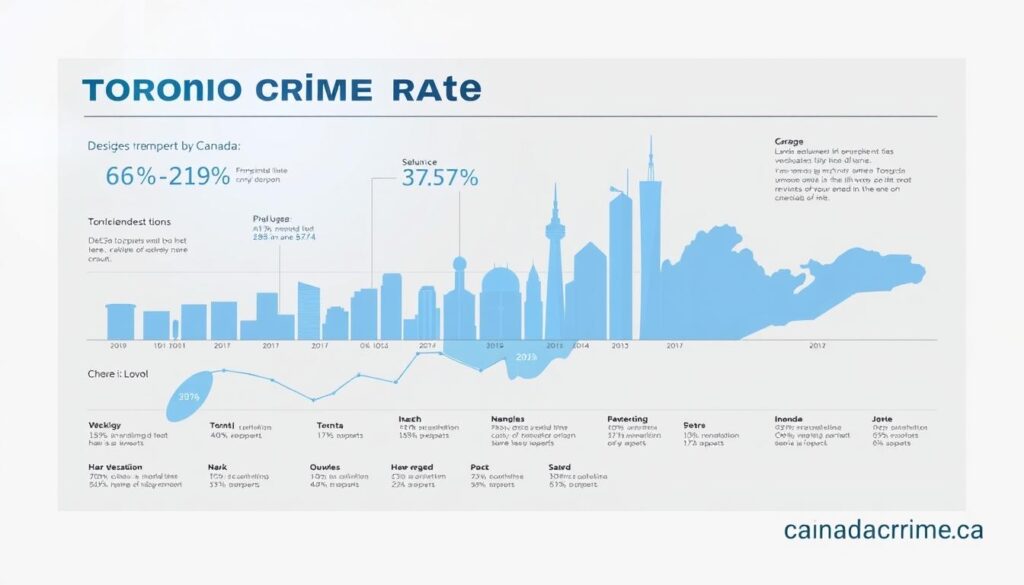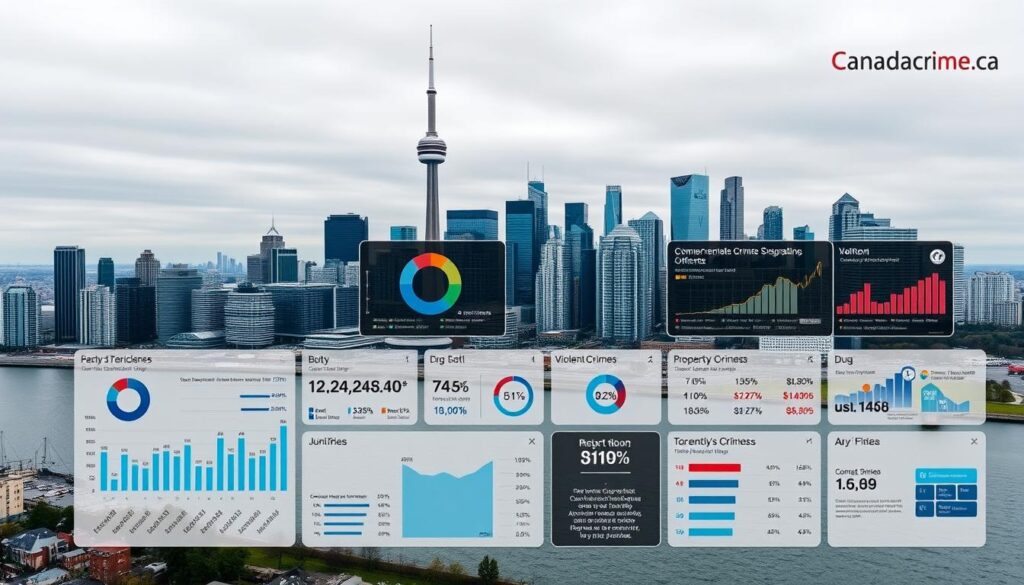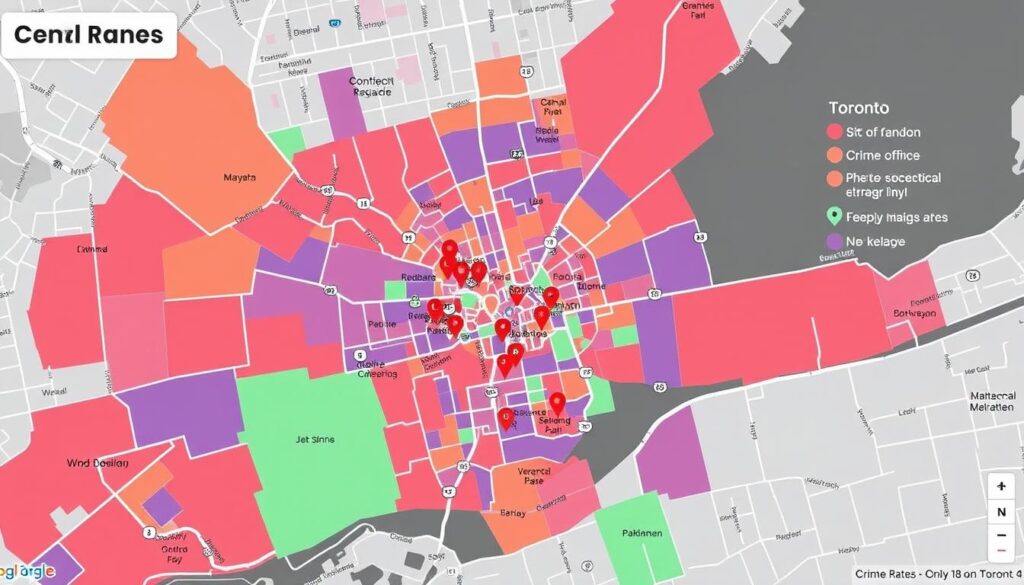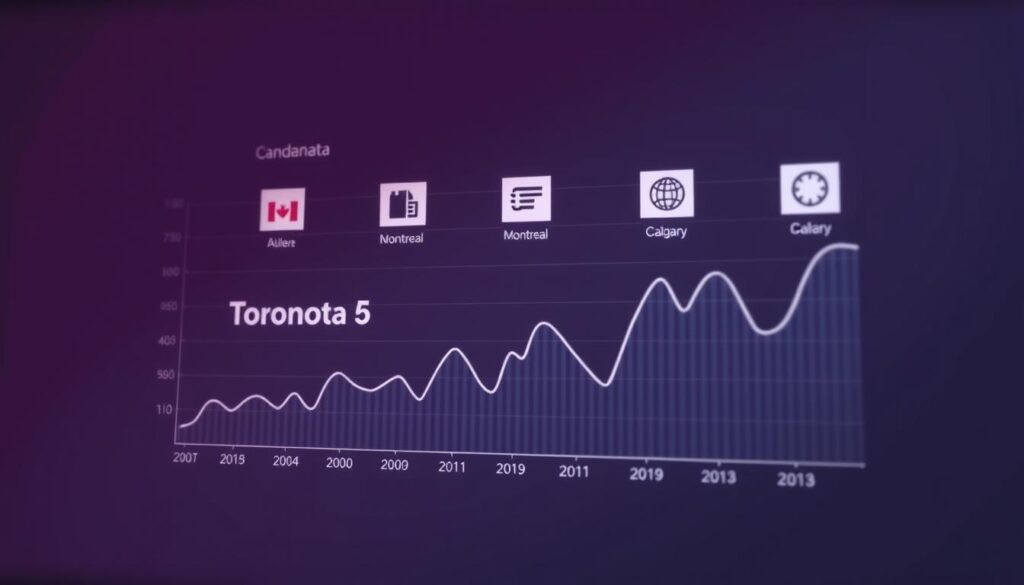Toronto, once a staple in the top 10 of the Global Liveability Index, fell to 12th place in 2024, according to The Economist Intelligence Unit (EIU). Despite this drop, the city remains one of the safest in the world, ranking 8th in personal security. With a crime rate of 286.9 offences per 100,000 residents in 2023, Toronto is considered Canada’s safest city, as reported by CTV News.
This comprehensive analysis will delve into Toronto’s crime data over the decades, examining trends and patterns in various crime categories, including homicides, assaults, and property crimes. By exploring historical crime data from the 1990s to the present, we’ll provide insights into Toronto’s safety landscape and its evolution over time.
The Current State of Crime in Toronto
Toronto’s crime landscape is undergoing a significant shift in 2024, with data from the Toronto Police Service indicating a decline in major crimes. The city’s crime rate has been a subject of interest, given its status as the fourth largest city in North America.
Toronto consistently ranks among the safest major cities on the continent, with a relatively low crime rate compared to many U.S. metropolitan areas. In 2024, The Economist ranked Toronto as the 6th safest major city globally and the safest in North America. This ranking underscores the city’s favorable safety profile internationally.
Safety Ranking in 2024
The safety ranking of Toronto in 2024 is a testament to the city’s efforts in maintaining law and order. According to CEOWORLD magazine, Toronto was ranked 160th globally, behind some Canadian cities but ahead of most American urban centers. This ranking highlights the city’s relative safety compared to other major cities worldwide.

Major Crime Indicators Overview
The Toronto Police Service tracks Major Crime Indicators, which include assault, auto theft, breaking and entering, robbery, sexual violations, and theft over $5,000. As of 2024, the statistics show that the 37,320 major crimes investigated by police year to date represent a decrease of 1.3% over the 39,019 reported by this time in 2023.
| Crime Category | 2023 | 2024 | Change |
|---|---|---|---|
| Major Crimes | 39,019 | 37,320 | -1.3% |
| Auto Theft | N/A | N/A | -21.1% |
Notably, auto theft experienced the most significant decrease (21.1%) in 2024, following a 25% increase in 2023. This fluctuation indicates that while Toronto maintains a favorable safety profile, certain crime categories continue to require attention.
“The decrease in major crimes in Toronto is a positive trend, but it’s essential to continue monitoring crime statistics to ensure the city remains safe.”
The data from the Toronto Police Service provides valuable insights into the city’s crime dynamics, helping to inform strategies for crime prevention and law enforcement.
Historical Toronto Crime Rate by Year
The historical crime rate in Toronto is a complex narrative shaped by drug trade, gang violence, and community dynamics. To understand the city’s crime trends, it’s essential to examine the significant events and statistics that have influenced crime rates over the years.

Crime Statistics from 1990-2000
The early 1990s were marked by a surge in violent crime in Toronto, largely due to the increasing violence among gangs and the introduction of crack cocaine in the late 1980s. In 1991, the city experienced its most violent year with 89 murders, 16 of which were linked to drug wars involving rival gangs. The late 1990s saw a gradual decline in violent crime, with 1999 recording only 49 homicides—the lowest total since 1986. This decline was significant, representing a murder rate of just 1.68 per 100,000 people across the Greater Toronto Area.
Crime Trends from 2000-2010
The 2000s began with moderate crime levels but saw a significant spike in 2005, dubbed the “Year of the Gun,” with 52 gun-related deaths out of 80 total homicides. This period highlighted the ongoing issue of gun violence in Toronto, which continued to be a concern for law enforcement and the community.
Crime Patterns from 2010-2020
From 2010 to 2020, Toronto experienced fluctuating crime rates. There was a notable decrease in shooting incidents from 2011 to 2014, reaching a decade-low of 196 incidents in 2014. However, the trend reversed beginning in 2016, with a steady increase in violent crime that culminated in 98 homicides in 2018—the highest total in the city’s history. This fluctuation underscores the dynamic nature of crime trends in Toronto, influenced by various factors including socio-economic conditions and law enforcement strategies.
Understanding Toronto’s Homicide Rates
Analyzing Toronto’s homicide rates provides insights into the city’s crime landscape and safety measures. The trend of homicides in Toronto has been a subject of interest, with the city experiencing fluctuations over the years. In recent times, Toronto has seen significant variations in its homicide rates, with certain years standing out due to higher numbers of homicides.

In 2018, Toronto recorded one of its highest homicide rates, surpassing even that of New York City. However, the subsequent year saw a decline in homicides. By 2024, the city witnessed another surge, with 86 homicides reported, translating to a homicide rate of approximately 3.1 per 100,000 residents.
Annual Homicide Statistics
The annual homicide statistics for Toronto from 1990 to 2024 reveal a fluctuating trend. Notable peaks were observed in 1991 with 89 homicides, 2018 with 98 homicides, and 2024 with 86 homicides. These statistics indicate that while there are periods of increase, there are also subsequent declines, suggesting the influence of various social and enforcement factors.
The cyclical pattern in homicide rates implies that specific initiatives and community responses play a role in shaping the city’s violent crime rates. Understanding these patterns is crucial for developing effective crime prevention strategies.
Gun-Related Deaths in Toronto
Gun-related deaths have been a significant component of Toronto’s homicides. The data shows a range from as low as 13 deaths in 1995 to as high as 52 in 2005 and 51 in 2018. The year 2018 was particularly notable for its high gun-related homicide rate, which contributed to the overall spike in homicides that year.
Despite the fluctuations, Toronto’s homicide rate, including gun-related deaths, has generally remained relatively low compared to major U.S. cities, typically ranging between 2.1 and 3.8 per 100,000 people throughout the 2010s. This comparison highlights the city’s relatively safer status, although the need for continued vigilance and effective policing strategies remains.
The “Year of the Gun” and Its Aftermath
In 2005, Toronto witnessed an unprecedented increase in gun-related homicides, which led to the coining of the term ‘Year of the Gun.’ This period was marked by a significant surge in violence, with gun-related homicides reaching a record 52 out of 80 total murders, nearly double the 27 gun deaths recorded the previous year.

Spike in Gun Violence
The year 2005 became infamous in Toronto due to the alarming rate of gun violence. The Boxing Day shooting on December 26, 2005, which resulted in the death of 15-year-old Jane Creba, was a watershed moment that shocked the city. This incident catalyzed public demand for stricter gun control measures and highlighted the urgent need for policy responses to address the rising gun violence.
Policy Responses and Community Impact
In response to the surge in gun violence, the federal government faced increased pressure to implement stricter gun control laws. The issue became a significant topic in the 2006 federal election, underscoring how urban violence had become a national concern. The aftermath saw increased police presence in high-risk neighborhoods, community mobilization efforts, and the implementation of youth engagement programs aimed at addressing the root causes of gun violence.
| Year | Total Homicides | Gun-Related Homicides |
|---|---|---|
| 2004 | 60 | 27 |
| 2005 | 80 | 52 |
| 2006 | 70 | N/A |
As the city grappled with the consequences of the “Year of the Gun,” it became clear that addressing gun violence required a multifaceted approach involving both policy changes and community engagement. The incident highlighted the need for continued efforts to reduce violence and improve public safety in Toronto.
“The ‘Year of the Gun’ was a wake-up call for Toronto, highlighting the need for a comprehensive strategy to combat gun violence and ensure public safety.”
Recent Crime Trends in Toronto (2015-2024)
Toronto has witnessed significant fluctuations in crime rates over the past decade, with a notable increase in violent crimes since 2016. The city’s crime landscape has been shaped by various factors, including shifts in policing strategies, socioeconomic conditions, and global events like the COVID-19 pandemic.
Shooting Incidents and Gun Violence
The past few years have seen a concerning rise in shooting incidents and gun violence in Toronto. According to the data, shootings and gun discharges have surged by nearly 34% compared to 2023, with 461 incidents recorded in 2024. This increase is a significant concern for law enforcement and the community.
The Toronto Police Service has intensified its efforts to address the rising gun violence, making approximately 940 firearm arrests in 2024, a 14% increase from 2023, and seizing roughly 700 guns. These actions demonstrate the police’s commitment to reducing gun-related crimes.
| Year | Shooting Incidents | Firearm Arrests | Guns Seized |
|---|---|---|---|
| 2023 | 344 | 823 | 610 |
| 2024 | 461 | 940 | 700 |
Pandemic Effects on Crime Rates
The COVID-19 pandemic had a significant impact on crime patterns in Toronto, with initial decreases in certain categories during lockdowns followed by increases as restrictions eased. The pandemic period (2020-2022) saw fluctuations in crime rates, with some types of crime decreasing while others increased.
Recent data shows that major crimes, including assault, auto theft, break and enter, robbery, sexual violence, and theft over $5,000, have decreased by approximately 3% year-over-year. However, the rise in shootings and gun discharges remains a concern.
Top Major Offences in Toronto
Toronto’s major crime categories reveal a complex picture of urban safety, with the Toronto Police Service’s annual reports offering a detailed breakdown. The data provides insights into various crime trends, helping to understand the city’s crime landscape.
Assault and Violent Crime Statistics
Assault remains the most prevalent major offence in Toronto, with 18,818 incidents reported in 2024, marking a 5.7% increase. This category includes 4,489 assaults with a weapon and 1,001 assaults causing bodily harm, highlighting the severity of violent crimes.
The Toronto Police Service’s report indicates a concerning rise in violent crime, with assault being a significant concern. The data suggests that violent crimes are a substantial portion of the overall crime rate in Toronto.
Property Crimes: Auto Theft and Breaking & Entering
Property crimes, such as auto theft and breaking and entering, continue to be significant concerns. Auto theft saw a 21.3% decrease in 2024, with 7,045 incidents reported, despite a 25% increase the previous year. Breaking and entering offences decreased slightly by 3.6%, with 5,030 incidents, including 1,072 cases of breaking and entering with intent.
| Crime Category | 2024 Incidents | Percentage Change |
|---|---|---|
| Auto Theft | 7,045 | -21.3% |
| Breaking and Entering | 5,030 | -3.6% |
Sexual Violations and Robbery Trends
Sexual violations have seen a concerning 13.1% increase, with 2,630 incidents reported in 2024. Robbery incidents also rose by 5.7%, with 2,312 cases, nearly half (988) involving weapons. These trends highlight the need for continued vigilance and effective crime prevention strategies.
The rise in sexual violations and robbery underscores the complexity of crime in Toronto, necessitating a multifaceted approach to address these issues.

Toronto Crime Rate by Neighbourhood

Toronto’s neighbourhoods exhibit a wide range of crime rates, reflecting the city’s diverse socioeconomic landscape. The Toronto Police Service’s Major Crime Indicators provide a detailed breakdown of crime statistics by neighbourhood, offering valuable insights into the safety of different areas.
Highest Crime Areas in Toronto
Some neighbourhoods in Toronto have significantly higher crime rates compared to others. According to the latest data, West Humber Clairville has the highest number of major crimes, with 1,570 incidents reported in 2024, representing a 30.5% increase from the previous year. Other areas with high crime rates include:
- Downtown Yonge East — 705 incidents (+2.5%)
- Moss Park — 695 incidents (+1.5%)
- York University Heights — 690 incidents (+1.2%)
- Yonge-Bay Corridor — 590 incidents (+0.7%)
- Kensington-Chinatown — 560 incidents (+1.8%)
These neighbourhoods are characterized by higher population density and commercial activity, which can contribute to increased crime rates.
Safest Neighbourhoods in Toronto
On the other end of the spectrum, some neighbourhoods in Toronto have remarkably low crime rates. Woodbine-Lumsden stands out as one of the safest areas, with only 50 major crimes reported in 2024, marking a significant 35% decrease from the previous year. This neighbourhood’s low crime rate can be attributed to various factors, including community engagement and effective policing strategies.
The data from the Toronto Police Service highlights the importance of targeted crime prevention initiatives and community safety programs in maintaining low crime rates across different neighbourhoods.
Transit Safety Concerns in Toronto
As Toronto continues to grow, ensuring the safety of its transit system remains a top priority for authorities and residents alike. The Toronto Transit Commission (TTC), which serves millions of riders daily, has faced challenges in maintaining a safe environment.
Violent Crimes on TTC
The TTC has experienced a troubling increase in violent incidents against passengers. In 2022, there was a 46% increase in violent incidents compared to the previous year, with 1,068 reported incidents. These included serious offenses such as assaults and other violent acts, creating widespread concern about transit safety. The rise in violence on Toronto’s transit system has been a significant concern for both the public and authorities.

Security Measures and Improvements
In response to the surge in violence, authorities have implemented comprehensive security enhancements. These include deploying 80 Toronto Police officers for 24-hour patrols, 20 community safety ambassadors, and 50 security guards throughout the system. As a result, there has been a notable decrease in offenses against TTC riders, with a 24% reduction between January 2023 and January 2024. This improvement suggests that the enhanced security measures are having a positive impact on transit safety.
The ongoing challenge of maintaining safety in a large and diverse transit system serving various neighborhoods highlights the need for continued vigilance and adaptive security strategies. Ensuring the safety of the city’s transit system is crucial for the well-being of its residents and visitors.
Organized Crime in Toronto
The landscape of organized crime in Toronto is complex and has evolved significantly over time. Large criminal organizations have been operating in the Toronto region since at least the mid-19th century, beginning with the homegrown, yet short-lived Markham Gang.

Since then, the landscape has shifted to become dominated by international or foreign-based crime syndicates. Italian organized crime remains prevalent, with groups like the Calabrian ‘Ndrangheta, including the Siderno Group, and the Sicilian Mafia operating sophisticated networks across the Greater Toronto Area.
Historical Development
Historically, Toronto became a major center for bootlegging operations into the United States during the Prohibition era, establishing connections between Toronto’s criminal elements and Italian-American organized crime, particularly the Buffalo crime family. Figures like Rocco Perri and his common-law wife Bessie Starkman played significant roles in Toronto’s organized crime scene during the 1920s, involved in smuggling alcohol into the United States and heroin into Canada.
Current Activities
Contemporary organized crime in Toronto has diversified beyond traditional Mafia activities. It now includes outlaw motorcycle gangs, international drug trafficking networks, human trafficking operations, and sophisticated auto theft rings operating across municipal and international boundaries. Law enforcement agencies have identified organized crime as a driving force behind many of Toronto’s serious criminal activities, including the recent surge in auto thefts, carjackings, and jewelry store robberies.
As stated by law enforcement officials, “Organized crime groups are highly adaptable and continue to exploit vulnerabilities in the city’s infrastructure and economy.” This adaptability poses a significant challenge for law enforcement agencies tasked with combating these crimes.
The impact of organized crime on families and communities in the Toronto area cannot be overstated. It is crucial for law enforcement and community programs to work together to address these issues effectively.
Canada’s Criminal Code and Toronto Crime
The Criminal Code of Canada is fundamental to addressing and preventing crime in Toronto. It provides the legal framework for understanding and tackling various criminal activities across the city.

Toronto’s crime landscape is influenced by several key provisions within the Criminal Code. These include laws related to violent crimes, property offenses, and organized criminal activities, all of which impact the city’s safety.
Key Provisions and Their Impact
The Criminal Code contains specific provisions that are crucial in addressing Toronto’s crime issues. For instance, laws regarding firearm offenses have been strengthened to combat gun violence. In 2024, the Toronto Police Service reported approximately 940 firearm arrests, a 14% increase from the previous year, and seized around 700 guns, demonstrating the practical application of these provisions.
- Gun-Related Offenses: Recent legislative reforms have focused on strengthening penalties for gun-related crimes, reflecting the city’s efforts to tackle gun violence.
- Repeat Offenders: The Criminal Code’s provisions on repeat offenders are a significant focus for Toronto law enforcement, with calls for justice reform to address the cycle of reoffending.
- Technological Advancements: The implementation of the Automated Licence Plate Recognition system has enhanced the enforcement of laws related to auto theft, with Toronto Police scanning over 1.1 million plates daily.
Recent Legislative Changes and Their Effects
Recent legislative changes have aimed to strengthen the legal response to crime in Toronto. The Toronto Police Service has advocated for further law reforms to address “indiscriminate and brazen shootings in public settings.” These changes reflect the ongoing efforts to enhance public safety and reduce crime.
By understanding and applying the provisions of Canada’s Criminal Code, Toronto can continue to develop effective strategies for crime prevention and law enforcement.
Toronto vs. Other Canadian Cities
Toronto emerges as the safest major city in Canada when crime rates are compared across different urban areas. According to a 2024 report by CTV News, Toronto’s crime rate stands at 286.9 offences per 100,000 residents, based on 2023 data, making it the city with the lowest crime rate among major Canadian cities.

Crime Rate Comparisons with Major Canadian Cities
Toronto’s crime rate is notably lower compared to other major Canadian cities. Quebec City ranks second with 301 offences per 100,000 people, followed by Ottawa-Gatineau, QC, with 318.8 offences per 100,000 people. This comparison considers various crimes such as arson, robbery, impaired driving, and burglary, highlighting Toronto’s strong safety record.
Despite being Canada’s largest city, Toronto maintains one of the lowest crime rates nationally. The city’s safety ranking is particularly noteworthy given its size and diversity, suggesting effective policing strategies and community safety initiatives.
Crime Severity Index Rankings
The Crime Severity Index (CSI), which weighs crimes based on their seriousness, consistently places Toronto among the safer major Canadian cities. While specific rankings may fluctuate annually, Toronto’s overall performance in the CSI reinforces its reputation as a safe urban center.
However, certain categories like auto theft and gun violence have seen significant increases in Toronto, sometimes exceeding rates in other Canadian cities. This highlights the complex nature of urban crime patterns and the need for continued vigilance and adaptive crime prevention strategies.
Key Statistics:
- Toronto’s crime rate: 286.9 offences per 100,000 residents
- Quebec City’s crime rate: 301 offences per 100,000 people
- Ottawa-Gatineau’s crime rate: 318.8 offences per 100,000 people
Toronto vs. International Cities
When comparing Toronto to other international cities, its crime statistics offer a compelling narrative of safety and security. Toronto is often evaluated against major cities worldwide to understand its standing in terms of crime and safety.
Comparison with American Cities
Toronto’s crime rate is notably lower than many American cities. For instance, in 2024, Toronto’s homicide rate was approximately 3.1 per 100,000 residents, significantly lower than cities like Chicago (18.5), Atlanta (19.0), and even New York City (5.1). This comparison highlights Toronto’s relative safety.
| City | Homicide Rate per 100,000 People |
|---|---|
| Toronto | 3.1 |
| New York City | 5.1 |
| Chicago | 18.5 |
| Atlanta | 19.0 |
Global Safety Rankings
Toronto consistently ranks high in global safety rankings. In 2024, The Economist ranked Toronto as the 6th safest major city globally and the safest in North America among 60 large urban centers. However, CEOWORLD magazine ranked it 160th globally, indicating varying perspectives on its safety relative to other cities, including some Canadian cities like Quebec City and Ottawa.
The city’s homicide rate has fluctuated between 2.1 and 3.8 per 100,000 people throughout the 2010s, making it comparable to modern-day New York but safer than many U.S. cities. Toronto’s overall safety profile is a positive aspect of its urban landscape.
Crime Prevention Initiatives in Toronto
The City of Toronto is pioneering a new approach to crime prevention through its comprehensive SafeTO Community Safety Plan. This 10-year initiative takes a holistic approach to reducing crime by addressing the root causes rather than just reacting to incidents after they occur.
The SafeTO plan focuses on interrupting cycles of violence through early intervention, particularly targeting youth-involved gun violence by creating positive alternatives and support systems for vulnerable young people. According to Coun. Alejandra Bravo, chair of the Economic and Community Development Committee, the plan aims to “look at aspects to stop the escalation of violence at its source.”
The SafeTO Community Safety Plan
The SafeTO initiative is a multifaceted, trauma-informed strategy that addresses underlying issues like poverty, precarious housing, unemployment, and lack of educational opportunities. Mohamed Shuriye, Toronto’s director of community safety and well-being, emphasizes that SafeTO aims to “redefine community safety” through this comprehensive approach.
One of the key components of SafeTO is the Toronto Community Crisis Service, launched city-wide in 2024 as the city‘s fourth emergency service. This service provides non-police responses to mental health crises, representing an innovative approach to public safety that reduces potentially volatile police encounters.
| Initiative | Focus Area | Impact |
|---|---|---|
| SafeTO Community Safety Plan | Youth-involved gun violence, poverty, housing | Reducing crime, improving community safety |
| Toronto Community Crisis Service | Mental health crises response | Reducing police encounters, improving public safety |
| Regent Park Social Development Plan | Community-specific crime prevention | Nearly two years without gun-related deaths |
Neighborhood Watch and Community Programs
Neighborhood-specific programs like the Regent Park Social Development Plan have demonstrated success, with the community celebrating nearly two years without gun-related deaths prior to an incident in early 2024. Community leaders like Walied Khogali Ali stress that addressing crime requires tackling “the big elephant in the room, which is chronic underfunding of the community.”
By investing in services and team efforts that support vulnerable populations, the city is working towards improving the quality of life for its residents. The SafeTO plan and other community initiatives underscore Toronto’s commitment to creating a safer, more supportive community for all.
Toronto Police Service’s Approach to Crime
The Toronto Police Service is tackling crime with a combination of traditional policing and innovative technologies. This multi-faceted approach is designed to address the complex and evolving nature of crime in Toronto.
Policing Strategies and Resources
The TPS has adopted a comprehensive strategy to combat crime, focusing on both enforcement and prevention. A dedicated investigative team was established to address the surge in auto thefts and carjackings, resulting in a reduction of these incidents by approximately 25% in 2024. This team has been instrumental in implementing targeted enforcement and prevention strategies.
The service has also intensified its focus on firearms, making approximately 940 firearm arrests in 2024, a 14% increase from 2023, and seizing roughly 700 guns. These efforts are part of a broader initiative to combat the 34% increase in shootings and gun discharges.
| Crime Category | 2023 Statistics | 2024 Statistics | Change |
|---|---|---|---|
| Firearm Arrests | 825 | 940 | +14% |
| Gun Seizures | 600 | 700 | +16.7% |
| Shootings and Gun Discharges | 250 | 335 | +34% |
Technology and Innovation in Crime Fighting
Technological innovation plays a central role in modern policing efforts. The Automated Licence Plate Recognition (ALPR) system has been implemented in nearly 600 police vehicles, scanning over 1.1 million plates daily and maintaining a database of more than 100,000 stolen vehicle plates from across Canada.
The TPS leadership has also advocated for justice reform to address repeat offenders, particularly those involved in violent crimes. This reflects a recognition that effective crime reduction requires changes beyond policing alone. Collaboration with community partners through the SafeTO framework represents an evolution in policing philosophy, acknowledging that sustainable crime reduction requires addressing root causes through partnerships with social services, community organizations, and other stakeholders.
By combining traditional policing methods with specialized units and technological innovations, the Toronto Police Service is working to create a safer city for its residents.
Social Factors Influencing Toronto Crime Rates
The fabric of Toronto’s society is intricately linked to its crime rates. As a city known globally for its safety, Toronto attracts thousands of people every year. However, beneath its safe exterior, the city grapples with significant social challenges that impact its crime rates.
According to Professor Ahmed Ilmi of the University of Toronto, “a world-class city comes with world-class issues,” highlighting that many of the brazen, violent crimes in Toronto are derived from wealth disparity. Economic inequality is a fundamental driver of crime, with research showing strong correlations between neighborhood poverty rates and violent crime incidents across the city.
Economic Disparities and Crime
Economic inequality stands out as a critical factor influencing crime rates in Toronto. The correlation between neighborhood poverty and violent crime is well-documented. As research on violent crime indicates, addressing economic disparities is crucial for crime prevention.
- Economic inequality correlates strongly with neighborhood poverty rates and violent crime incidents.
- Wealth disparity is identified as a key factor behind many violent crimes in Toronto.
- Community leaders emphasize tackling poverty and community disconnection through sustained investment in social programs.
Youth Engagement as a Preventive Measure
Youth engagement has emerged as a critical focus in crime prevention. Experts stress the need to provide meaningful alternatives and opportunities for young people to prevent them from being drawn into criminal activities. Social media’s influence on youth behavior, creating a generation of “instant wants, needs and consumptions,” combined with poverty and inequality, can lead to negative consequences.
The success of targeted social development plans in neighborhoods like Regent Park demonstrates that comprehensive approaches addressing economic opportunity, education, mentorship, and community cohesion can significantly reduce crime rates.
By understanding and addressing the social factors that influence crime rates, Toronto can continue to be a safe and welcoming city for its residents and newcomers alike.
The Future of Public Safety in Toronto
Toronto’s public safety landscape is undergoing a significant transformation, focusing on integrated models that combine traditional policing with community-based initiatives. This shift is evident in the city’s evolving approach to addressing crime and enhancing community safety.
The expansion of the Toronto Community Crisis Service as the city’s fourth emergency service represents a significant step toward non-police responses to mental health situations. By providing alternative responses to crisis situations, the city aims to reduce confrontational encounters and improve outcomes for individuals in need. This innovative approach has the potential to enhance public safety while also addressing the root causes of crime.
In neighborhoods like Regent Park, community empowerment has led to a growing sense of local pride and safety. Residents are developing “a local approach to supporting each other” following violent incidents, illustrating the value of fostering community ownership in enhancing neighborhood safety. As Ali, a resident of Regent Park, noted, “It’s also about fostering trust, equity, and access to essential services like mental health support.” This approach highlights the importance of community-led initiatives in preventing crime and promoting public safety.
The future of public safety in Toronto will depend on continued investment in affordable housing, youth programming, mental health services, and economic opportunities. By addressing the underlying causes of crime, the city can achieve sustainable improvements in public safety. Furthermore, technological innovations in policing, such as advanced surveillance systems and data-driven deployment strategies, will play an increasingly important role in crime prevention and response.
Ultimately, Toronto’s success in enhancing public safety will rely on its ability to maintain multicultural harmony while addressing economic inequality and providing pathways to success for young people across all communities. By working together, the city can create a safer, more equitable environment for all its residents, fostering a sense of community and improving the quality of life for families and individuals alike.

